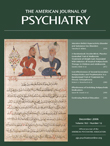Despite widespread acceptance that most psychiatric disorders are “diseases of the brain”
(1), the field of psychiatry has thus far failed to identify a single neurobiological marker that is diagnostic of a mental disorder
(2) . There are a number of potential advantages to including laboratory tests in diagnostic criteria. In contrast to the clinical signs and symptoms that form the basis for the current DSM criteria, laboratory tests are more objective
(3), would facilitate detection of mental disorders in primary care settings
(4), and would highlight the neurobiological basis of psychiatric disorders.
Although many candidate laboratory tests have been proposed over the years—for example, the dexamethasone suppression test
(5) and shortened REM latency for major depression
(6) —none has been found to be sufficiently sensitive and specific to be suitable for psychiatric diagnosis. However, despite these limitations, it may still be possible and indeed advantageous to include laboratory tests in at least some of the criteria sets in DSM-V. Many disorders in DSM-IV are defined polythetically, that is, a minimum number of items are required from a list of symptoms (e.g., three out of a list of seven symptoms for substance dependence). In polythetically defined disorders, the individual criteria vary in their sensitivity and specificity (for examples, see references
7 –
12 ). Consequently, rather than considering whether a laboratory test by itself is sufficiently sensitive and specific to make a particular psychiatric diagnosis, we should ask how well the laboratory test performs as compared to the other criteria used to define the disorder. A methodology for exploring this issue was established by a group of investigators including one of us
(13), using data from 1,138 psychiatric outpatients obtained through the Rhode Island Methods to Improve Diagnostic Assessment and Services (MIDAS) project. We demonstrated significant variability in the sensitivities and specificities for the symptom criteria for major depressive disorder. The sensitivity and specificity values ranged from 90.2% and 84.9%, respectively, for depressed mood down to 66.9% and 78.2% for appetite/weight disturbance. By contrast, a study examining all-night EEG sleep studies
(14) was able to correctly classify 82% of a mixed group of normal subjects, patients with primary depression, and patients with primary insomnia. Although these diagnostic efficiency statistics were determined in separate studies that used different definitions of depression, thereby limiting the validity of a direct comparison, it suggests the possibility that the diagnostic efficiency of EEG sleep analysis might perform as well as, or better than, some of the current symptom criteria for major depressive disorder. Potentially, the combination of clinical signs and symptoms and laboratory tests that optimally defines major depressive disorder (in terms of predictive validity of course and treatment response) could be determined and incorporated into the polythetic list of criteria for major depression.
During DSM-IV deliberations, practical concerns were raised about including laboratory test results in the definition of psychiatric disorders; this might render it impossible for a general clinician without access to the necessary laboratory equipment or facilities to make a psychiatric diagnosis
(15) . However, since polythetic criteria sets do not require the presence of any one particular item to make the diagnosis, the general clinician will still be able to make the diagnosis even if laboratory testing is not available.
Ultimately, the decision as to whether to include laboratory tests in DSM-V diagnostic criteria sets will require a careful balancing of the benefits versus costs. However, embedding laboratory tests with less-than-perfect diagnostic sensitivity and specificity parameters in polythetic criteria sets may finally allow the inclusion of objective laboratory tests into DSM-V diagnostic definitions.

